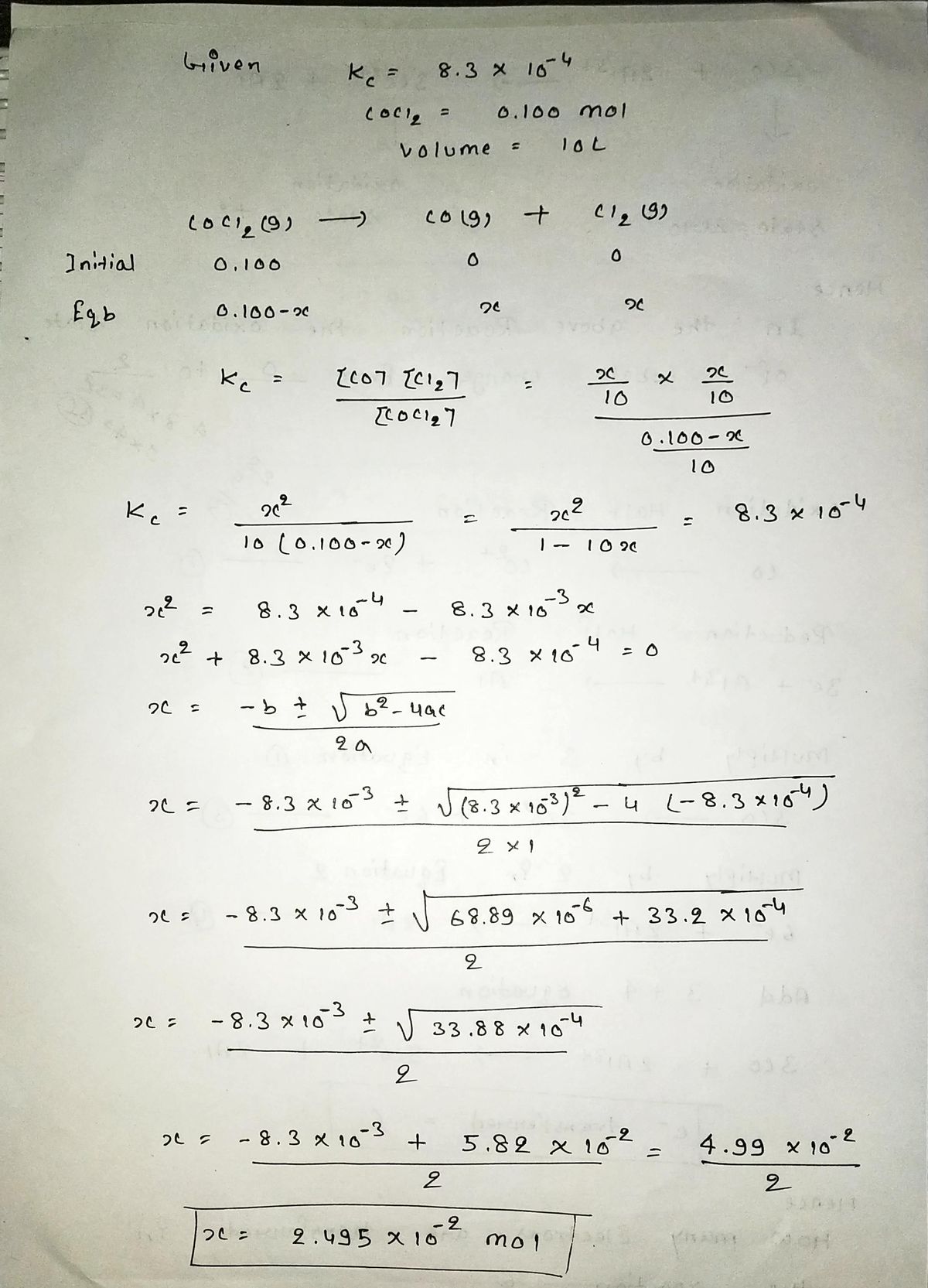1002X) 7. Phosgene is a potent chemical warfare agent that is now a agreement. It decomposes by the reaction COC1₂ (g) CO (g) + Cl₂ (g) Kc = 8 Calculate all species, when 0.100 mol of COCl2 was decomp 10.0 L flask.
1002X) 7. Phosgene is a potent chemical warfare agent that is now a agreement. It decomposes by the reaction COC1₂ (g) CO (g) + Cl₂ (g) Kc = 8 Calculate all species, when 0.100 mol of COCl2 was decomp 10.0 L flask.
Chemistry
10th Edition
ISBN:9781305957404
Author:Steven S. Zumdahl, Susan A. Zumdahl, Donald J. DeCoste
Publisher:Steven S. Zumdahl, Susan A. Zumdahl, Donald J. DeCoste
Chapter1: Chemical Foundations
Section: Chapter Questions
Problem 1RQ: Define and explain the differences between the following terms. a. law and theory b. theory and...
Related questions
Question
100%
7 please
![**Phosgene Decomposition Reaction**
Phosgene is a potent chemical warfare agent that is now outlawed by international agreement. It decomposes by the reaction:
\[ \text{COCl}_2 \, (g) \rightleftharpoons \, \text{CO} \, (g) + \text{Cl}_2 \, (g) \]
The equilibrium constant (\( K_c \)) for this reaction at 360°C is \( 8.3 \times 10^{-4} \).
**Problem Statement:**
Calculate all species when 0.100 mol of COCl₂ was decomposed and reached equilibrium in a 10.0 L flask.
**Solution Overview:**
The reaction is analyzed for equilibrium concentrations using the provided \( K_c \) value. Initial concentrations, changes in concentrations due to equilibrium shift, and equilibrium concentrations are typically set up using an ICE table (Initial, Change, Equilibrium) approach.
**Notes:**
- The handwritten calculations seem to address setting up an equation based on the equilibrium constant expression and solving for the concentrations of each species at equilibrium. The expression could result in a quadratic equation solved for the change in concentration (usually denoted as 'x').](/v2/_next/image?url=https%3A%2F%2Fcontent.bartleby.com%2Fqna-images%2Fquestion%2F3f4c86b2-1247-4388-bf18-f90827f5643c%2F61f649e1-76fc-48c7-af64-5a49c9e82bc2%2Fr1ldmo_processed.jpeg&w=3840&q=75)
Transcribed Image Text:**Phosgene Decomposition Reaction**
Phosgene is a potent chemical warfare agent that is now outlawed by international agreement. It decomposes by the reaction:
\[ \text{COCl}_2 \, (g) \rightleftharpoons \, \text{CO} \, (g) + \text{Cl}_2 \, (g) \]
The equilibrium constant (\( K_c \)) for this reaction at 360°C is \( 8.3 \times 10^{-4} \).
**Problem Statement:**
Calculate all species when 0.100 mol of COCl₂ was decomposed and reached equilibrium in a 10.0 L flask.
**Solution Overview:**
The reaction is analyzed for equilibrium concentrations using the provided \( K_c \) value. Initial concentrations, changes in concentrations due to equilibrium shift, and equilibrium concentrations are typically set up using an ICE table (Initial, Change, Equilibrium) approach.
**Notes:**
- The handwritten calculations seem to address setting up an equation based on the equilibrium constant expression and solving for the concentrations of each species at equilibrium. The expression could result in a quadratic equation solved for the change in concentration (usually denoted as 'x').
Expert Solution
Step 1

Step by step
Solved in 2 steps with 2 images

Knowledge Booster
Learn more about
Need a deep-dive on the concept behind this application? Look no further. Learn more about this topic, chemistry and related others by exploring similar questions and additional content below.Recommended textbooks for you

Chemistry
Chemistry
ISBN:
9781305957404
Author:
Steven S. Zumdahl, Susan A. Zumdahl, Donald J. DeCoste
Publisher:
Cengage Learning

Chemistry
Chemistry
ISBN:
9781259911156
Author:
Raymond Chang Dr., Jason Overby Professor
Publisher:
McGraw-Hill Education

Principles of Instrumental Analysis
Chemistry
ISBN:
9781305577213
Author:
Douglas A. Skoog, F. James Holler, Stanley R. Crouch
Publisher:
Cengage Learning

Chemistry
Chemistry
ISBN:
9781305957404
Author:
Steven S. Zumdahl, Susan A. Zumdahl, Donald J. DeCoste
Publisher:
Cengage Learning

Chemistry
Chemistry
ISBN:
9781259911156
Author:
Raymond Chang Dr., Jason Overby Professor
Publisher:
McGraw-Hill Education

Principles of Instrumental Analysis
Chemistry
ISBN:
9781305577213
Author:
Douglas A. Skoog, F. James Holler, Stanley R. Crouch
Publisher:
Cengage Learning

Organic Chemistry
Chemistry
ISBN:
9780078021558
Author:
Janice Gorzynski Smith Dr.
Publisher:
McGraw-Hill Education

Chemistry: Principles and Reactions
Chemistry
ISBN:
9781305079373
Author:
William L. Masterton, Cecile N. Hurley
Publisher:
Cengage Learning

Elementary Principles of Chemical Processes, Bind…
Chemistry
ISBN:
9781118431221
Author:
Richard M. Felder, Ronald W. Rousseau, Lisa G. Bullard
Publisher:
WILEY